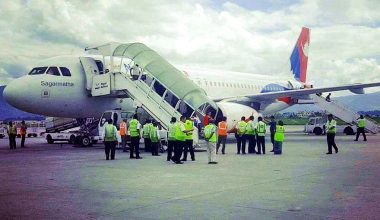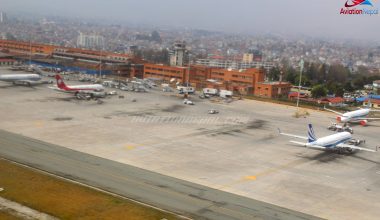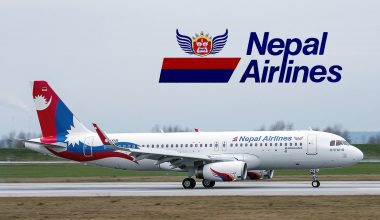Review of Investigation Report: Nepal Airlines crash on 16’Th Feb 2014
Aviationnepal- 31 August 2016
The final report of NAC Accident (16’th Feb 2014), which was prepared by Aircraft Accident Investigation commission constituted by the government of Nepal and MOTCA has been reviewed only for further improvement of Investigation so that we can prevent accident in future through best practice of Investigation. This review has nothing to do with this accident report and does not even calming to reopen the same case but these suggestions can be implemented for on-going or future Investigation.
Synopsis according to Report (for reference only)
On 16 Feb. 2014 (2070-11-4 B.S.) The Twin Otter aircraft (DHC-6/300), 9N-ABB, owned and operated by Nepal Airlines Corporation (NAC) was on scheduled flight from Kathmandu to Jumla. The flight was scheduled for technical landing i.e. for refuelling purpose at Pokhara Airport. After refuelling, the aircraft departed Pokhara at 0658 UTC (12:43 LT) for destination Jumla airport. Since few days back weather over the country was deteriorated due to western disturbance. Jumla weather though not favourable in the morning, later in the afternoon it was improved and reported VFR.
Upon leaving Pokhara Control Zone, PIC realized that the direct track was not possible due weather and decided to proceed via South. During the flight pilots were experiencing uncomfortable flying environment due to unfavourable weather condition. In course of avoiding weather pilots had to fly up and down and changing the heading. Finally being unable to penetrate the weather ahead PIC decided to divert to Bhairahawa, the nearest airport. During this endeavour to come out of the weather and in an attempt to divert to Bhairahawa, the PIC did not take into consideration the surrounding terrain and continued descent turning right. The aircraft initially slashed a small tree and finally hit the sloppy ridge with the huge impact. Due to the heavy impact the left wing was first disintegrated and then the front part of the aircraft toppled over beyond the ridge with several subsequent impacts.
Search and Rescue was not possible on that day due to bad weather. Crashed aircraft was located next day. All 18 persons on board were found dead. Aircraft was completely damaged and wreckages were scattered around 2 kilometres over and beyond the hill.
The Government of Nepal, Ministry of Culture, Tourism and Civil Aviation formed a four member Aircraft Accident Investigation Commission on 17 February 2014 to probe into the circumstances and probable cause of the accident for the purpose of preventing reoccurrence of similar accident in future and enhancing flight safety.
After detailed investigation and thorough analysis of the circumstances and evidences, the Commission determined that the most probable causes of the accident was the
“Losing situational awareness on the part of PIC while flying into instrument meteorological weather condition to the extent of collision with terrain.”
The contributing factors to the occurrence ware;
– Deteriorated weather associated with western disturbance, unstable in nature and embedded CB.
– Inappropriate and insufficient crew coordination while changing course of action,
Analysis of the report:
As we can clearly see the probable cause of this accident was “Losing situational awareness on the part of PIC while flying into instrument meteorological weather condition to the extent of collision with terrain.”Which is human error off course but the investigation team has not covered any investigation regarding human error in this report. Most of the Nepalese aviation accidents are caused by Human Error and at the same time none of the investigation team has done any investigation regarding human error. Investigating Human error is one of the toughest investigations but it does not mean that we cannot investigate that in Nepal.
When considering human error, an understanding of the unsafe conditions that may have affected human performance or decision-making is required. These unsafe conditions may be indicative of systemic (or latent) hazards that put the entire aviation system at risk. Consistent with the systems approach to safety, an integrated approach to safety investigations considers all aspects that may have contributed to unsafe behaviour or created unsafe conditions. That’s why it’s mandatory to investigate human error.
The focus of an accident investigation should be directed towards effective preventive action. With the investigation directed away from the chase for the guilty party and towards effective preventive action, cooperation should be fostered among those involved in the accident, facilitating the discovery of the underlying causes. The short-term expediency of finding someone to blame is detrimental to the long-term goal of preventing accidents.
Typically, incidents and accidents involve several, often inter-linked errors. Each error should be investigated to determine the most serious underlying contributory factors such as Communication Error, proficiency Error, Operational Decision Error, Intentional Non-Compliance Error etc. Systematically investigating these human errors requires an integrated approach. In attempting to identify the underlying factors affecting human behaviour which may have led to an occurrence, the investigator should have used the following reasoning:
a) Was the behaviour or decision intentional or unintentional?
b) If it was unintentional:
1) Was it a slip, whereby, the person knew what was required but unintentionally did something else?
2) Was it a lapse whereby the person again knew what was required, but forgot (e.g. missed an altitude call-out)?
3) Was the unintentional behaviour the result of: Unfamiliarity with a new procedure or new work environment? Lack of skill or currency?Inattention (due to distraction, fatigue, complacency, etc.)?
- c) If it was intentional:
1) Was it a genuine mistake (perhaps due to an inappropriate plan)?
2) Was it a deliberate violation of prescribed operating procedures?
3) Were any mistakes in decision-making due to: Inadequate knowledge for the conditions?Ambiguous or inadequate rules governing the procedure?Biases in decision-making? — Memory problems?
4) Were any deliberate violations due to:Misunderstanding of correct procedures? Corporate climate of indifference? Exceptional deviation due to actual conditions (e.g. weather, aircraftserviceability, security issue)?
Most of the mentioned reasons were not investigated for this particular accident. If we cannot investigate each reasons of human error we cannot prevent any accident for future.
The commission has also failed to investigate details about Organization and management factors. For examples,
1)Flight manuals has not been investigated for any procedure fault (if investigated should have mentioned in section 1.18 in report).
2) Flight time duty time limitation procedure was not reviewed as it might cause human error.
3) Crew Resource Management Training procedure and Syllabus was not reviewed even CRM was one of the major cause of Accident.
4) Awareness Training for crew member was not investigated, In Nepal we might need some extra Awareness training for crew member like Monsoon Training.
5) Civil Aviation Authority of Nepal (CAAN) Oversight function should have been investigated; CAAN might fail to review all above mentioned compliance while renewing Air Operator Certificate (AOC). Investigation Team can Recommend if there is any discrepancies.
Investigation team should have conducted a survey for fatigue because human error is one of the major causes for accident and team should know how fatigue out pilots are and is there any non-compliance for same.
Team should have investigated about the CAAN Procedure for same scenario as mentioned in synopsis, so that CAAN can improve their procedure (We have similar Accidents in Nepal).
Safety recommendations should have clearly articulated that what must be done, not like “Encourage Airlines to install on-board aircraft equipment that will help for real time tracking of the aircraft in flight” Since the purpose of the safety recommendation is to convince others of an unsafe condition putting some or all of the system at risk, specific language should be used in summarizing the scope and consequences of the identified risks.
The accident prevention value of an accident, or a hazard, or incident report is proportional to the quality of the investigative effort. Ideally each occurrence should be investigated to the point where all associated risks are identified.
Article By – Bikal Jha
Aviation Lecturer – MCBS (OMAN)






